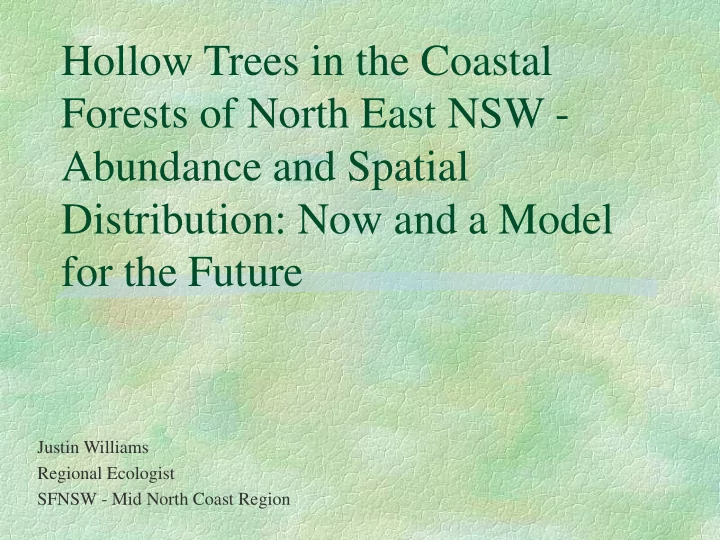

Hollow Trees in the Coastal Forests of North East NSW - Abundance and Spatial Distribution: Now and a Model for the Future Justin Williams Regional Ecologist SFNSW - Mid North Coast Region
Hollow Tree Summary Many species require tree hollows for nest/den sites which may take 150-250 years to develop Studies on hollow development and numbers required on few eucalypt species and mostly relate to clearfall silviculture Data for North Coast NSW predict 3-13 hollow trees/ha required before other factors such as food and predators limit wildlife populations
Recent Regional Forest Agreement Increased Area of Reserves - 54% of public land reserved Management conditions on production forests effect the number and distribution of hollows Baseline number of hollows trees to be retained: 5/ha
Identifying Current Distribution and Abundance of Hollow Trees Mapped strata developed - broad forest type & growth stage Forest inventory plots across strata Identify average number of hollow trees per strata Map distribution of hollow trees using strata averages
Current Abundance of Hollow Trees Strata Area Avg Strata Area Avg (%) No/Ha (%) No/H a Regrowth 4 7 Mixed Age 17 14 Blackbutt Moist Hardwood Regrowth 3 10 Mixed Age Mixed 24 13 Moist Hardwood Hardwood Regrowth Mixed 4 7 Mixed Age Spotted 9 6 Hardwood Gum/Blackbutt Regrowth 3 3 Mixed Age Dry 10 10 Spotted Sclerophyll Gum/Blackbutt Regrowth Dry 1 15 Old Regrowth 9 5 Sclerophyll Blackbutt Mixed Age 5 9 Old Regrowth 4 13 Blackbutt Moist Hardwood Rainforest with 8 11 Average 10 Emergent Euc’s 14
Predicting Future Abundance of Hollow Trees Matrix of likelihood of hollow trees: tree species and size class Grow stands with yield simulation tool used to predict future timber volumes Apply matrix to tree lists produced from yield simulator to predict likelihood of future tree containing hollows
Example: Proportions of trees with hollows for five species in the 40-60, 60-80, 80-100 & 100+ cm diameter size classes 100% Proportion of Trees With Hollows 80% 40-60 GYG 60% 60-80 80-100 40% 100+ 20% 0% GYG WMY TWD SBG BBT Species
Model of number of trees with hollows today and in 100 years in harvested and not harvested areas Strata Today Harvested Not Harvested Young Regrowth 7 12 22 Blackbutt Old Regrowth 5 10 27 Blackbutt Mixed Age Mixed 13 14 27 Hardwood Mixed Age Dry 10 13 20 Sclerophyll Forest Weighted Average 10 12 24 All 13 strata
Model of the number of trees/ha with hollows for a 200 year period under three silvicultural scenarios 30 25 Number/ha 20 Actual 15 STS Heavy No Harvest 10 5 0 2000 2025 2050 2100 2200 Year
Average number of hollow trees/ha across landscape including harvested and reserved areas 25 20 15 10 5 0 Y2000 Y2025 Y2050 Y2100 T2200
Modelling Future Distribution of Hollow Trees Produce grid of strata and management intent across landscape Reference grid with future hollow matrix to produce grid with number of hollows Spatial analysis to predict distribution of hollow trees across landscape
~ .. Rainforest Example Forest Landscape - .. Harvesting Exclusions I:=] New National Park Bellangry State Forest (2000 ha) State Forest
~ ~ ~ 3-6 Hollow Trees/ha .. Rainforest 6 - 10 Hollow Trees/ha .. Harvesting Exe Example Forest Landscape c=J New National P 11 - 15 Hollow Trees/ha Number of Hollow Trees- Present .. 16 -22 Hollow Trees/ha c=J State Forest - 23 - 35 Hollow Trees/ha
-~,~-~- ~ ~ ~ ~ ~ Example Forest Landscape 3-6 Hollow Trees/ha - Rainforest 6 - 1 O Hollow Trees/ha - Harvesting Exclusion: Number of Hollow Trees-100 years Time 11 - 15 Hollow Trees/ha New National Park Normal Silviculture .. 16 - 22 Hollow Trees/ha State Forest - 23 - 35 Hollow Trees/ha
Summary of Results Produced useful base-line data on the size-classes where species develop hollows and produced a realistic model to predict the future abundance of hollows The model predicts that the RFA outcome will result in significant increase in number of hollow trees over the long-term and maintain existing numbers in the short- term
a a
~I ~- ._~ I 12 - 24 ~ I _ I Example Forest Landscape 6,000 ha 100 - 150 Average Distance (m) to Mapped Exclusion Area I I 24-501 150- 175 Normal Silviculture 70 I I 175- 3808 50 _ Avg Distance to Exclusion 70 m Median Distance 50 m
Model of Number of Hollow Trees/ha - Actual Silviculture for 3 habitat strata 18 15 12 No/ha DBBT_E 9 MBBT_C 6 TDE_ABC Mean 3 0 2000 2025 2050 2100 2200 Year
Proportion of Trees with Hollows in the 80-100 cm size class for 8 common species in four site height categories 100% 80% 60% <27 28-33 40% 34-40 40+ 20% 0% MY SPG SBG YG BBT BBX WD LW G W T B
Recommend
More recommend